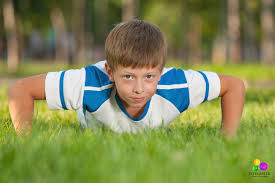Written by: John Hallam (Bach. Ex.Sci) Personal Trainer / Strength and Conditioning Coach
We know that exercise is an essential component to you leading a healthy and energetic lifestyle. However, while most parents and coaches share positive attitudes regarding children performing aerobic activities (running, playing sport etc) there remains an overwhelming concern in the community when it comes to children performing strength training.
Whilst we are NOT proponents of your child just turning up to your local gym and undertaking a random exercise program – the scientific research demonstrates there are great benefits for children undertaking a structured and supervised strength training routine. But lets examine the MYTHS.
We’ve all heard it before….
“Strength training at a young age will stunt growth.”
Myth! Extensive research has found no evidence to suggest adverse effects on growth and development, nor is there any evidence that training has an impact on final adult height. In fact, strength training has a great number of positive effects including:

- Increased strength (due to neuromuscular adaptation, not muscle growth)
- Increased bone-mineral density
- Increased aerobic fitness
- Improved body composition (muscle vs. fat)
- Increased resistance to injury
- Improved attitude towards lifetime physical activity
“Training at an early age places them at high risk of injury”
Participation in any sport, at any age has inherent risk injury. Injuries can be caused as a result of the body exerting an internal force (producing movements such as kicking a ball, throwing a ball, running on a track etc.) or having force directed on the body (being tackled, landing from a jump, falling to the ground). The purpose of a training program should be to condition and prepare the child’s body for the forces expected to be encountered in their chosen sport/s.
As a result, an athlete that has practiced exerting forces and having forces acted on their body is more robust, resilient and at a lower risk of injury than an athlete that hasn’t.
Children should not be considered as “small adults” and train at an intensity and manner suitable for much older participants. Strength training should also not just be thought of as lifting heavy barbells and being drenched in sweat. Building a solid foundation of correct movement patterning is far more important than their maximal capacity to lift, and proper technique should always be the priority. Children should be exposed to a wide variety of exercises and movements including bodyweight, bands, bilateral and unilateral movements, plyometric and balance to name a few. As such children should always be supervised by an exercise professional in order to prescribe appropriate exercises for their individual needs and abilities.
At the end of the day, a child or adolescent has many years to develop not only their strength, but also their confidence and abilities in performing exercise. There shouldn’t be an expectation for exercise intensity to increase session to session and rush exercise progressions. Most importantly the child should be having fun and see exercise as enjoyable and not a forced task.
About the Author: John Hallam is a strength and conditioning coach working with elite juniors at Eastern Ranges F.C along with being a personal trainer at Inspire Fitness for Wellbeing.
